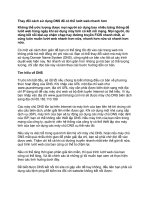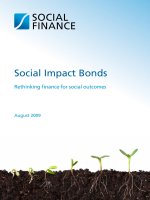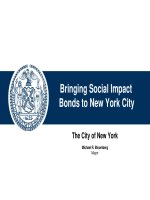Tài liệu Bringing Social Impact Bonds to New York City: The City of New York pdf
Bạn đang xem bản rút gọn của tài liệu. Xem và tải ngay bản đầy đủ của tài liệu tại đây (428.97 KB, 7 trang )
Confidential Draft- For Discussion Purposes Only
Bringing Social Impact
Bonds to New York City
The City of New York
Michael R. Bloomberg
Mayor
What are Social Impact Bonds?
• A Social Impact Bond is an investment vehicle designed to
encourage private funding for promising social programs
– Taps into new funding opportunities
– Private investors fund a program’s delivery and operations
• Public sector commits to paying the contractor only if
improved social outcomes are achieved
– Taxpayers only pay for interventions that work
• Third-party evaluation confirms that outcomes have been
achieved before investors can be paid
• Concept is relatively new and New York City will be the
first in the nation to implement this innovative financing
model
2
What are the Benefits?
• Investing in outcomes to improve the lives of those in need
• Government is able to preserve public resources for successful
interventions while still encouraging innovation in a time of fiscal
constraints
– Savings can be recaptured and reinvested into a permanent funding
stream for the program
– Accelerate adoption and implementation of promising programs
– Brings added discipline to measuring outcomes for government
programs because there is an upfront agreement on how to measure
success
• Nonprofit providers receive a committed funding stream not
subject to budget cuts
• Can produce financial returns for private investors, who assume
the risk while achieving a public good
3
Partners
4
• Goldman Sachs funds the project’s delivery and operations
through a $9.6 million loan to MDRC;
• Bloomberg Philanthropies provides a $7.2 million grant to
MDRC to guarantee a portion of the investment;
• MDRC oversees the day-to-day implementation of the project
and manages the Osborne Association and Friends of Island
Academy, the two non-profit service providers that deliver the
intervention;
• The Vera Institute of Justice, an independent evaluator,
determines whether the project achieves the targeted
reductions in reincarceration;
• The Department of Correction pays MDRC based on reduced
re-admissions and the associated cost savings and MDRC then
pays the private investor.
Addressing Adolescent Incarceration in NYC
• Issue: those who enter jail as adolescents (16- to 18-year olds) have a
high likelihood of re-entering the system in the years following their
release
– Nearly 50% of 16- to 18-year-olds who leave Rikers return within one year
• Program: Adolescent Behavioral Learning Experience (“ABLE”)
– Provide evidence-based intervention to 16-18 year olds in DOC custody at Rikers
Island and after release in the community
– The goal is to improve social decision-making, problem solving and self-control skills
management.
– Estimated roughly 3,000 adolescents served each year for 4 years
– The Osborne Association and Friends of Island Academy will deliver the intervention
through trained facilitators working closely with DOE and DOC staff
– Part of Mayor’s Young Men’s Initiative and the City’s commitment to improving
outcomes for young black and Latino men
• Goal: to decrease participants’ likelihood of future criminal behavior
and reincarceration
• Budget: $2.4 million annually for 4 years
5
• Goldman Sachs will invest $9.6 million in the intervention, fully funding the ABLE
program at Rikers Island during its implementation. This investment will be
structured as a loan to MDRC, a leading non-profit.
• The Goldman Sachs loan to MDRC will ensure successful implementation of the
ABLE program at Rikers.
• Bloomberg Philanthropies will make a grant to MDRC in the amount of $7.2 million
over that same four-year period. This grant will be held by MDRC in a guarantee fund
to back the loan.
• DOC will be obligated to pay for these services only if the ABLE program achieves
predetermined reincarceration reduction targets that produce cost savings for the
City.
— In this model, government and taxpayers only pay for success.
• Payments for services performed are tied to the program’s success and are made
from DOC to MDRC. MDRC, in turn, repays its lender, Goldman Sachs.
Funding & Payment: The SIB Component of ABLE
6
Payment Terms for Final Evaluation
(4 Years of Investment)
* Savings after repayment and continued funding for program delivery.
.
7
Reduction in Reincarceration
City Payment to MDRC ($)
Projected Long-Term City Net
Savings ($)*
≥20.0%
$11,712,000
$20,500,000
≥16.0%
$10,944,000
$11,700,000
≥13.0%
$10,368,000
$7,200,000
≥12.5%
$10,272,000
$6,400,000
≥12.0%
$10,176,000
$5,600,000
≥11.0%
$10,080,000
$1,700,000
≥10.0% (breakeven)
$9,600,000
$ ≥ 1,000,000
≥8.5%
$4,800,000
$ ≥ 1,000,000









